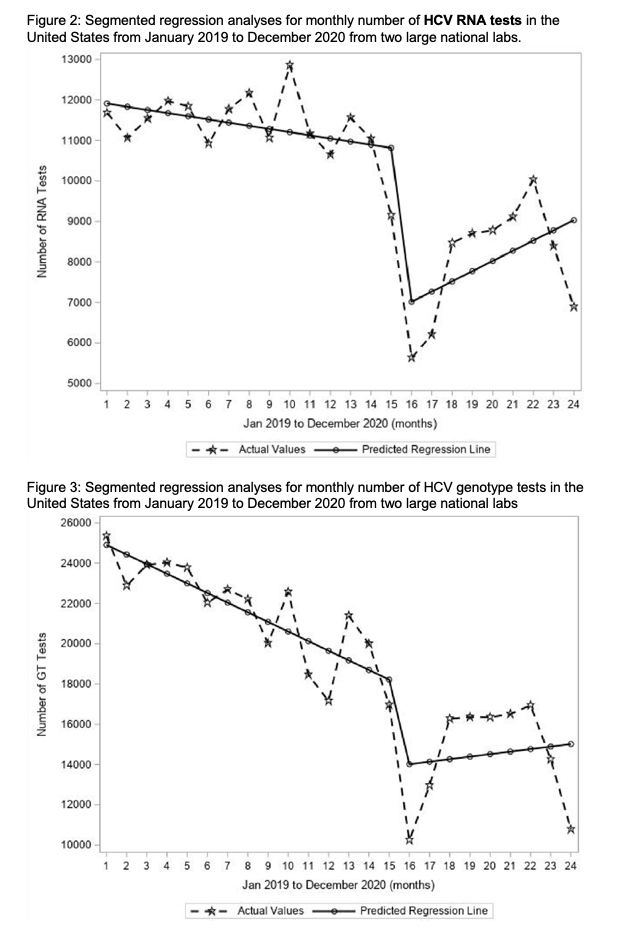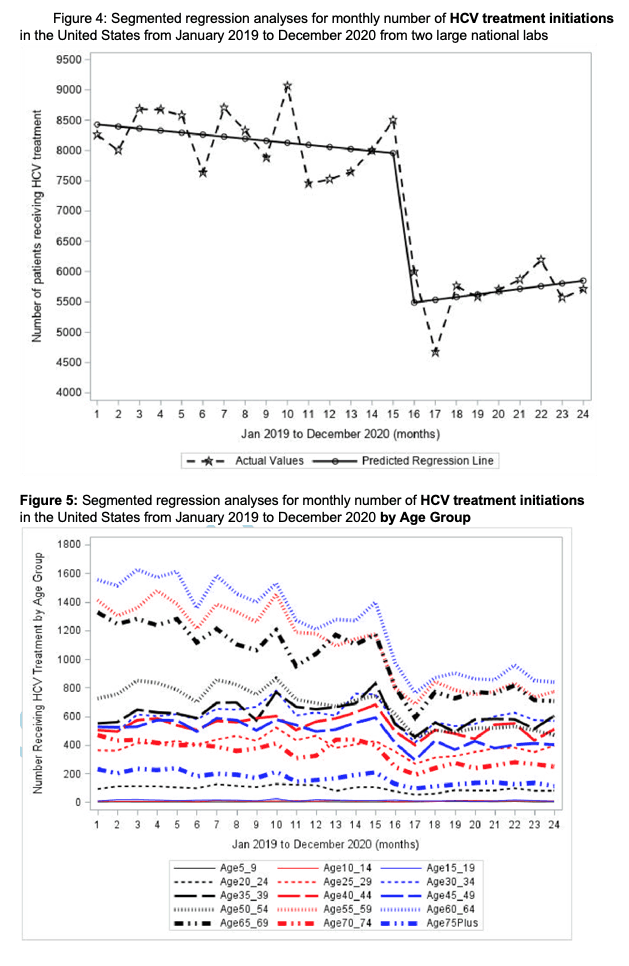| |
Sustained impact of the COVID-2019 pandemic
on HCV treatment initiations in the United States
|
| |
| |
Clinical Infectious Diseases 02 March 2022
Martin Hoenigl, MD; Daniela Abramovitz, MS; Ricardo E. Flores Ortega, MPH; Natasha K.
Martin, DPhil*; and Nancy Reau, MD
HCV treatment initiation
During the pre-COVID period, HCV treatment initiations (predicted n=8,463 before the observation period) were stable, but dropped significantly from March 2020 to April 2020 by 31% (decrease of 2,512 treatment initiations/month, p<0.001; Figure 4) and remained low throughout the remainder of the year during the COVID period.
States who did not adopt Medicaid expansion did have a significant month-to-month decrease in HCV treatment initiations during Pre-covid (p=0.014), whereas the states that adopted Medicaid did not (p=0.3) (Supplementary Figure 5 and 6). However there was no difference in the trend after April 2020 between states that adopted Medicaid and those that did not (both p<0.001) (Supplementary Figure 5 and 6). In sub-analyses, there were also similar trends in HCV treatment declines across age groups (Figure 5) and by state (Supplementary Figure 7, New York, California, Illinois and Florida).
Abstract
Background
Recent reports indicated declines in HCV testing during the first half of 2020 in the United States due to COVID-19, but the longer-term impact on HCV testing and treatment is unclear.
Methods
We obtained monthly state-level volumes of HCV antibody, RNA and genotype testing and HCV treatment initiation, stratified by age and gender, spanning January 2019 until December 2020 from two large national labs (Quest and LabCorp). We performed segmented regression analysis for each state from a mixed effects Poisson regression model with Month as the main fixed predictor, and State as a random intercept.
Results
During the pre-COVID period (January 2019-March 2020), monthly HCV antibody and genotype tests decreased slightly while RNA tests and treatment initiations remained stable. Between March and April 2020, there were declines in the number of HCV antibody tests (37% reduction, p<0.001), RNA tests (37.5% reduction, p<0.001), genotype tests (24% reduction, p=0.023) and HCV treatment initiations (31%, p<0.001). Starting April 2020 through the end of 2020 there were significant increases in month-to-month HCV antibody (p<0.001), RNA (p=0.035), and genotype tests (p=0.047), but only antibody testing rebounded to pre-COVID levels. HCV treatment initiations remained low after April 2020 throughout the remainder of the year.
Conclusion
HCV testing and treatment dropped by over 30% during April 2020 at the start of the COVID pandemic, but while HCV testing increased again later in 2020, HCV treatment rates did not recover. Efforts should be made to link HCV positive patients to treatment and revitalize HCV treatment engagement by health care providers.
Figure 2: Segmented regression analyses for monthly number of HCV RNA tests in the
United States from January 2019 to December 2020 from two large national labs.
Figure 3: Segmented regression analyses for monthly number of HCV genotype tests in the
United States from January 2019 to December 2020 from two large national labs
Figure 4: Segmented regression analyses for monthly number of HCV treatment initiations
in the United States from January 2019 to December 2020 from two large national labs
Figure 5: Segmented regression analyses for monthly number of HCV treatment initiations
in the United States from January 2019 to December 2020 by Age Group


| |
| |
| |
|
|
|